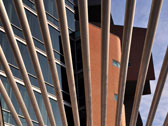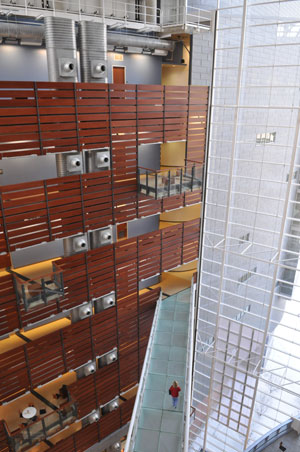Sustainability 101: UC Heads the Class
UC Green Programs combine academic, community goals in the name of sustainability.

 Late February may be the dead of another gloomy Cincinnati winter, but very green things are happening around Uptown. The University of Cincinnati’s sustainability initiative, UC|Sustainability, is making progress toward a range of environmentally conscious goals, many of which go far beyond the UC campus.
Late February may be the dead of another gloomy Cincinnati winter, but very green things are happening around Uptown. The University of Cincinnati’s sustainability initiative, UC|Sustainability, is making progress toward a range of environmentally conscious goals, many of which go far beyond the UC campus.
The roots of this sustainability initiative run back decades, said program coordinator Sean Tubb.
“Students, instructors and faculty have been interested since the 1970s,” he said.
 Former university president Joseph Steger moved UC toward sustainable design with his call in 1999 for sustainable campus buildings, and a sustainability committee formed in 2003 to provide a focal point for green-focused work on campus. In 2007, former UC president Nancy Zimpher signed the American Colleges and University Presidents’ Climate Contract, a promise by more than 600 institutions to turn their campuses carbon-neutral by 2050.
Former university president Joseph Steger moved UC toward sustainable design with his call in 1999 for sustainable campus buildings, and a sustainability committee formed in 2003 to provide a focal point for green-focused work on campus. In 2007, former UC president Nancy Zimpher signed the American Colleges and University Presidents’ Climate Contract, a promise by more than 600 institutions to turn their campuses carbon-neutral by 2050.
“It’s been an ongoing process,” said Tubb of UC’s long relationship with sustainability.
Part of the process included the formation of the President’s Advisory Council on Environment and Sustainability, or PACES, a committee that helps guide new initiatives on campus and in the community. The programs PACEs launched, helped facilitate or partnered to create are having a big effect on the area’s environmental face.
First, there are the buildings. Six of UC’s West Campus buildings qualify for a level of LEED environmentally friendly certification, thanks to careful design and energy planning. And Tubb said that a two-year, $18 million plan is working to make the university’s science labs more energy efficient. Along with better insulation and windows in the buildings, Tubb said UC is installing sensors that will cut down on excess ventilation in infrequently used lab spaces. While he did not know how much money the moves would save, he sounded confident it would be significant.
“They wouldn’t have invested that if they didn’t expect a return on investment,” he added.
 Other sustainability projects could make the university a regional leader. A plan to reduce and better control the various campuses’ storm water runoff could produce new technology and techniques for other large organizations to use, he said.
Other sustainability projects could make the university a regional leader. A plan to reduce and better control the various campuses’ storm water runoff could produce new technology and techniques for other large organizations to use, he said.
“I think that might be something very cutting edge, at least regionally,” he added.
And another energy-awareness project could soon bring changes to non-college classrooms in the Queen City. UC|Sustainability students worked last year in conjunction with General Electric and Cincinnati Public Schools to conduct energy audits for CPS’s elementary schools. Tubb said the school district is using the audits to guide an aggressive efficiency upgrade in the elementary school buildings.
According to Chad Edwards, chair of the U.S. Green Building Council’s Cincinnati Chapter, that kind of partnership is making Cincinnati into a leader in sustainable practices.
“When we go to regional and national conferences and others hear we’re from Cincinnati, they want to learn how we’re able to do all these things,” he said, referring to the area’s state-leading rank in numbers of green buildings.
Members of the council’s board actively volunteer to work with UC|Sustainability projects, and several board members teach sustainability, design and planning classes at the university.
“We have members that are very actively engaged,” he added.
 For students interested in sustainability, the university now offers an increasing range of options that range from theory-based to very practical.
For students interested in sustainability, the university now offers an increasing range of options that range from theory-based to very practical.
“We try to get students, faculty and staff into the local neighborhoods to show them part of sustainability is giving back socially and financially to the community,” said Tubb.
PACES hosts a variety of films, lectures and workshops throughout the year, and Tubb added that he intends to offer a variety of hands-on volunteer activities this spring.
UC is also approaching sustainable behavior on a broader scale, with two projects that could change the city’s perception of who UC students are and what they do. A bike-sharing program is being developed that would not only cut down on Uptown’s school-year traffic and parking headaches, but would also improve air quality and student health while creating a positive image of UC students and faculty/staff around the city. PACES developed the program to go hand-in-hand with UC’s and the city’s bicycle access master plans, and Tubb said UC bikes could be tooling around the region as soon as Spring Quarter.
UC students also now have a chance to grow their own produce, thanks to a year-old urban garden program that allowed students to farm vegetables at a lot on Westwood-Northern Boulevard last year.
 “That’s something students are really excited about,” said Tubb. He added that the university is working to expand the program to a second plot within walking distance of campus. That would make fresh, local-as-it-can-get produce available to students who aren’t able to drive to a distant plot.
“That’s something students are really excited about,” said Tubb. He added that the university is working to expand the program to a second plot within walking distance of campus. That would make fresh, local-as-it-can-get produce available to students who aren’t able to drive to a distant plot.
The ripples of the sustainability work underway at UC will be felt in the future workforce – the first class of Sustainability minors graduated in June 2009 – but some ripples are being felt now. Edwards noted that the Cincinnati chapter of the U.S. Green Building Council was picked to host the 2011 Greening the Heartland Conference, an honor that will see more than 1,000 green building council members coming to Cincinnati to learn about the latest sustainable building practices.
“Cincinnati is, from the outside looking in, is one of the leaders in sustainability,” he said. “A lot of that came through these partnerships.”
Photography by Scott Beseler













